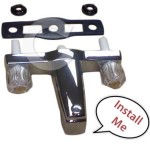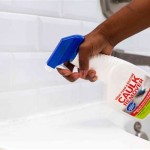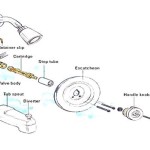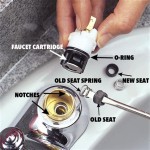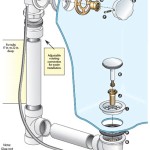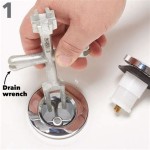Hand Held Shower Head for Bathtub Faucet: A Comprehensive Guide
The convergence of convenience and functionality in bathroom fixtures has led to the increased popularity of hand-held shower heads designed for bathtub faucets. These systems offer a versatile showering experience, allowing for targeted rinsing, assisting in cleaning the bathtub, and providing accessibility for individuals with mobility limitations. This article delves into the features, benefits, selection criteria, installation procedures, and maintenance requirements associated with hand-held shower heads designed specifically for bathtub faucets.
Understanding the Components and Functionality
A hand-held shower head system for a bathtub faucet typically consists of several key components. These include the shower head itself, designed to deliver water in various spray patterns. A flexible hose connects the shower head to the diverter valve, allowing for extended reach within the bathing area. A diverter valve redirects water flow from the bathtub faucet to the hand-held shower head. Mounting brackets or holders secure the shower head when not in use. Each component collaborates to provide a functional and adaptable showering experience.
The shower head’s design often incorporates multiple spray settings, ranging from a focused stream to a wide, massaging spray. These settings can be adjusted to accommodate individual preferences and cleaning requirements. The flexible hose is generally constructed from durable materials such as stainless steel or reinforced polymer tubing, ensuring longevity and resistance to kinks or leaks. The diverter valve is a crucial element, allowing for seamless switching between the standard bathtub faucet and the hand-held shower head. Its reliability is paramount to the overall performance of the system.
The operational principle is straightforward. When the diverter valve is set to the bathtub faucet position, water flows normally through the faucet. When the diverter valve is switched to the shower head position, water is redirected through the hose to the hand-held shower head, providing a controlled and directed spray. The pressure and temperature of the water remain consistent with the settings on the bathtub faucet handles.
Benefits of Installing a Hand-Held Shower Head
The installation of a hand-held shower head for a bathtub faucet offers a multitude of benefits that extend beyond simply providing an alternative showering method. These benefits encompass hygiene, accessibility, convenience, and cleaning efficiency.
One significant advantage is improved hygiene. The targeted spray of a hand-held shower head allows for more thorough rinsing, ensuring that shampoo and soap residues are effectively removed from the hair and body. This is particularly beneficial for individuals with thick hair or sensitive skin, where complete rinsing is essential to prevent irritation or skin conditions.
Accessibility is another key benefit. For individuals with limited mobility, such as the elderly or those recovering from injuries, a hand-held shower head provides a safer and more comfortable showering experience. It eliminates the need to stand for extended periods or maneuver under a fixed shower head, reducing the risk of slips and falls. The extended reach of the hose allows for seated showering or bathing, promoting independence and dignity.
Convenience is also a major factor driving the popularity of these systems. The ability to direct the spray precisely where it is needed is particularly useful for washing children or pets. It simplifies the process of rinsing hair or cleaning specific areas of the body without requiring full immersion in the bathtub. The hand-held shower head can also be used to apply therapeutic water treatments or to massage sore muscles.
Cleaning efficiency is enhanced by the focused spray capabilities of the hand-held shower head. It allows for easy rinsing of the bathtub after use, removing soap scum and other residues. This reduces the effort required for cleaning and helps to maintain a hygienic bathing environment. The versatility of the spray settings also allows for targeted cleaning of grout lines and other hard-to-reach areas.
Factors to Consider When Choosing a Hand-Held Shower Head
Selecting the appropriate hand-held shower head for a bathtub faucet requires careful consideration of several factors. These factors include the type of diverter valve, the length and material of the hose, the spray patterns offered by the shower head, the overall design and aesthetic, and the ease of installation and maintenance.
The type of diverter valve is a critical consideration. Common types include two-way and three-way diverters. A two-way diverter simply switches between the bathtub faucet and the shower head. A three-way diverter offers an additional option, such as a separate tub spout filler, providing greater flexibility. The choice depends on the existing plumbing configuration and the desired functionality.
The length and material of the hose are important for ensuring both reach and durability. A longer hose provides greater flexibility but may also be more prone to tangling. Stainless steel hoses are generally more durable and resistant to corrosion than plastic hoses. Reinforced polymer tubing offers a balance of flexibility and durability.
The spray patterns offered by the shower head should be considered in relation to individual preferences and needs. Some shower heads offer a wide range of spray patterns, including full body spray, massage spray, pulsating spray, and mist spray. The ability to adjust the spray pattern allows for a customized showering experience. Low-flow shower heads are also available, which conserve water without sacrificing performance.
The overall design and aesthetic should complement the existing bathroom decor. Hand-held shower heads are available in a variety of finishes, including chrome, brushed nickel, oil-rubbed bronze, and matte black. The style of the shower head should also be consistent with the other fixtures in the bathroom.
Ease of installation and maintenance is another important consideration. Some hand-held shower heads can be installed without the need for special tools or professional assistance. Clear and comprehensive installation instructions are essential. The shower head should also be easy to clean and maintain, with features such as rubber nozzles that can be easily wiped clean to remove mineral deposits.
Installation Procedures for Hand-Held Shower Heads
The installation of a hand-held shower head for a bathtub faucet is typically a straightforward process that can be accomplished with basic plumbing tools and skills. However, it is essential to follow the manufacturer's instructions carefully to ensure a proper and leak-free installation. The general steps involved in the installation process are outlined below.
First, gather the necessary tools and materials. These typically include an adjustable wrench, Teflon tape, a screwdriver, and the hand-held shower head kit, which should include the shower head, hose, diverter valve, mounting bracket, and installation instructions. Turn off the water supply to the bathtub faucet to prevent leaks during the installation process. This can usually be done by shutting off the shut-off valves located under the sink or near the bathtub.
Next, remove the existing bathtub spout. Depending on the type of spout, this may involve unscrewing it from the faucet pipe or loosening a set screw. Clean the faucet pipe thoroughly to remove any old Teflon tape or debris. Wrap the faucet pipe with new Teflon tape, applying several layers in a clockwise direction. This will help to create a watertight seal.
Attach the diverter valve to the faucet pipe, screwing it on tightly by hand. Then, use an adjustable wrench to tighten it further, ensuring that it is securely in place. Be careful not to overtighten, as this could damage the valve or the faucet pipe. Connect the shower hose to the diverter valve, again using Teflon tape to ensure a watertight seal. Tighten the hose connection securely with an adjustable wrench.
Attach the shower head to the other end of the hose, using Teflon tape on the threads. Tighten the connection securely with an adjustable wrench. Mount the shower head holder or bracket to the wall near the bathtub, using screws or adhesive. Ensure that the holder is positioned at a convenient height and angle. Finally, turn on the water supply and test the hand-held shower head for leaks. Check all connections carefully and tighten them further if necessary.
Maintenance and Troubleshooting
Regular maintenance is essential to ensure the longevity and optimal performance of a hand-held shower head system. This includes cleaning the shower head nozzles to remove mineral deposits, inspecting the hose for leaks or damage, and lubricating the diverter valve to ensure smooth operation. Troubleshooting common problems can also help to keep the system functioning properly.
Mineral deposits can accumulate in the shower head nozzles over time, reducing water flow and affecting the spray pattern. To clean the nozzles, soak the shower head in a solution of vinegar and water for several hours or overnight. This will help to dissolve the mineral deposits. Use a small brush or pin to remove any remaining debris. Some shower heads have rubber nozzles that can be easily wiped clean.
Inspect the hose regularly for leaks, cracks, or kinks. If the hose is damaged, it should be replaced to prevent leaks and water damage. Check the connections at the diverter valve and shower head to ensure that they are tight. Tighten them if necessary, using an adjustable wrench. Lubricate the diverter valve periodically with a silicone-based lubricant. This will help to keep it operating smoothly and prevent it from sticking.
Common problems with hand-held shower head systems include low water pressure, leaks, and a sticking diverter valve. Low water pressure can be caused by mineral deposits in the shower head nozzles or by a partially closed shut-off valve. Clean the shower head nozzles and check the shut-off valve to ensure that it is fully open. Leaks can be caused by loose connections or damaged components. Tighten all connections and replace any damaged parts. A sticking diverter valve can be caused by mineral deposits or a lack of lubrication. Clean the valve and lubricate it with a silicone-based lubricant.
By following these maintenance and troubleshooting tips, homeowners can ensure that their hand-held shower head systems remain in good working order for many years.

Danco Versa Spray 1 Portable 2 In Freestanding Handheld Shower Head Sprayer For Bathtubs Without Diverter White 10086 The Home Depot

Danco Versa Spray 1 Portable 2 In Freestanding Handheld Shower Head Sprayer For Bathtubs Without Diverter White 10086 The Home Depot

Proox Bathroom Tub Faucet With Diverter Bath Head Hose Bathtub Spout 6 Sprayer Handheld Shower Com

Bathtub Shower Attachment Decor Ideas

Danco Versa Spray 1 Portable 2 In Freestanding Handheld Shower Head Sprayer For Bathtubs Without Diverter White 10086 The Home Depot

Handheld Showerhead Guide The Basics Homeability Com

Versaspray Portable Hand Held Shower Head Sprayer For Bathtubs Without Diverter Danco

How To Switch Out Wall Mounted And Handheld Showerheads Dengarden

Roman Tub Faucet With Handheld Shower Shamanda

Thermostatic Bathtub Faucet Wall Mount Gray Tub Filler Hand Held Shower Head Tap
Related Posts

